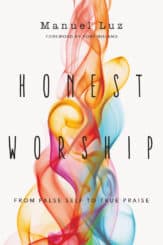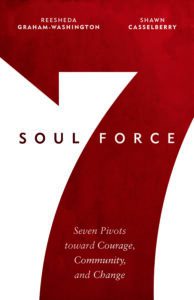
My teenage son, Justin, had been invited to an area church by a friend. Since he had grown up as a pastor’s kid and had never been to a megachurch like this before, I wondered what impression it might give him.
Sure enough, soon after his experience, Justin asked me a question: “Why do they need smoke machines in church?”
“Why do they need smoke machines in church?”
There was much I could have said in that moment. I could have contrasted different philosophies of ministry, especially in relation to the seeker movement in our postmodern culture, and explained how some view the Sunday service as having components of both worship and evangelism. I could have articulated the differences between entertainment and engagement and how the two, while they may look similar, are very different in intent and outcome. And I could have passionately shared my deeply held convictions on worship theology, what it means to come before the throne of God as the people of God, the bride and the Bridegroom, the community of believers with the community of the Godhead. But I didn’t.
Instead, I simply replied, “Well, technically, you need the smoke machines to be able to see the lasers.”

Generalizing broadly, worship in a number of churches today is a far cry from that of previous generations. Computer-controlled concert lighting, digital automated sound systems, high decibels, and high-definition screens create a dynamic, multisensory experience. On the expansive platform, talented musicians command center stage, performing the current worship songs with note-for-note perfection, underscored by click tracks and drum loops. Ushers greet people warmly, offering earplugs along with the bulletins. There’s an emphasis on branding, social media, and corporate organization. There may even be a hipster self-awareness that permeates the room, an anti-fashion fashionableness.
These churches, which some refer to as “attractional model,” carefully and purposefully design high-impact experiences to attract people to their weekend services. With roots that trace through the seeker movement of the eighties and nineties, they understand that high production values and marquee personalities both attract nonbelievers and retain believers. High-tech media and pop style are the vernacular of modern culture and can be used to effectively speak into that culture. And to these churches’ credit, many people come and worship God, mature as Christians, and share their faith.
…high production values and marquee personalities both attract nonbelievers and retain believers.
Smaller churches, which often sit in the shadows of their neighboring megachurches, are also swept into the slipstream of this cutting edge. Small and medium-sized churches are often caught in the whirlwind of trying to modernize technology, media, facilities, web presence—and talent. Even volunteer worship leaders feel the pressure to “sound like the record” when they lead worship.
Due to the explosion of the worship industry in the last decade (from CDs to radio airplay to major concert tours), musical selection in worship services has become more important than ever. People want to hear their latest favorite worship songs. And while the worship wars of the previous generation are generally a distant memory, we are still jounced by their wake. Hymn books, pipe organs, and choirs have become anachronisms. Some churches have settled on separate services, providing traditional and blended alternatives. While this pragmatism has proved workable for many churches, the issue remains that worship has too often devolved into stylistic preferences.
In the midst of these sweeping trends, some attenders succumb to the temptation to church-hop, sampling church services like so many downtown restaurants. Many older attendees are unsettled, even exasperated by the changes, and make it their business to rally for some semblance of familiarity, for hymns and “praise choruses.” Some, young and old, unimpressed by the high production values of today’s churches, are instead turning to liturgy, to quieter, ancient-future expressions of the faith, in order to meet an unhurried God. Others, seeking more organic community, are attending intimate, high-touch house churches.
But the disturbing trend is that some people—from boomers to millennials—are choosing to leave the institution of the church entirely. Perhaps they have been jaded by the experience of church or the attitudes of the attendees, like Dorothy discovering the wizard behind the curtain. Or perhaps the world’s distractions are simply too big and too loud to ignore.
Certainly the church is in flux. And the implications for worship—and the worshiper—are many.
Now, I’m not doubting the sincerity or integrity of any of these churches or of their leaders. I firmly believe that these churches are filled with good-hearted, God-focused people who are trying to do their best to further the kingdom. I also don’t have anything against high-tech production or hip music or excellence in the arts. Cutting-edge worship music is a staple at the church I pastor, and for many years I’ve been an outspoken advocate for the arts in the church and for artists of faith. This is an exciting time to be an artist of faith, and I’m grateful to be a part of it all. Further, I have many friends and associates who minister in both small churches and megachurches, and I know them to be God-honoring Christ-followers.
But there are pitfalls and tripwires all around these issues of which we must be acutely aware. As A. W. Tozer warned, “Worship is no longer worship when it reflects the culture around us more than the Christ within us.”
“Worship is no longer worship when it reflects the culture around us more than the Christ within us.”
At the crux of all these trends is the desire to help worshipers worship, to meet God in a transcendent and transformative way, and to give God glory. And that’s a good thing. The holes in our hearts can be filled only by God, and it is the calling of the church to help people become heart-filled and soul-alive.
 Manuel Luz is the creative arts pastor of Oak Hills Church in Folsom, California, and has been an active advocate for worship and the arts for more than twenty-five years. He is a working musician and songwriter, co-inventer of the musical instrument the WalkaBout, and the author of Imagine That and Honest Worship: From False Self to True Praise, from which this excerpt is taken with permission from InterVarsity Press.
Manuel Luz is the creative arts pastor of Oak Hills Church in Folsom, California, and has been an active advocate for worship and the arts for more than twenty-five years. He is a working musician and songwriter, co-inventer of the musical instrument the WalkaBout, and the author of Imagine That and Honest Worship: From False Self to True Praise, from which this excerpt is taken with permission from InterVarsity Press.


